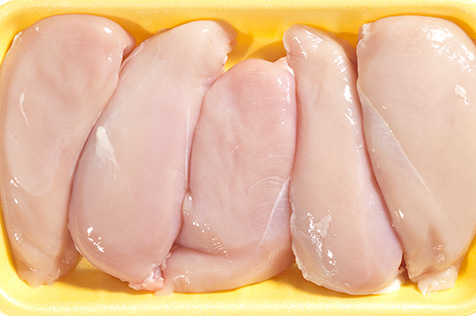What You Need to Know
- You can take steps to prevent getting food poisoning from chicken.
- Use a food thermometerexternal icon to make sure chicken is cooked to a safe internal temperature of 165°F.
- Keep raw chicken and its juices away from ready-to-eat foods, like salads or food that is already cooked.
- Do not wash raw chicken. During washing, chicken juices can spread in the kitchen and contaminate other foods, utensils, and countertops.

Americans eat more chicken than any other meat. Chicken can be a nutritious choice, but raw chicken is often contaminated with Campylobacter bacteria and sometimes with Salmonella and Clostridium perfringens bacteria.
If you eat undercooked chicken, you can get a foodborne illness, also called food poisoning. You can also get sick if you eat other foods or beverages that are contaminated by raw chicken or its juices.
CDC estimates that every year in the United States about 1 million people get sick from eating contaminated poultry. Ten-year-old AJ was one of those people. Watch AJ and his mother talk about the serious Salmonella infection he got from eating chicken.
You Can Take Steps to Prevent Food Poisoning
If chicken is on your menu, follow these tips when shopping, cooking, and eating out to help prevent food poisoning:
- Place chicken in a disposable bag before putting it in your shopping cart or refrigerator to keep raw juices from getting onto other foods.
- Wash hands with warm, soapy water for 20 seconds before and after handling chicken.
- Do not wash raw chicken. During washing, chicken juices can spread in the kitchen and contaminate other foods, utensils, and countertops.
- Use a separate cutting board for raw chicken.
- Never place cooked food or fresh produce on a plate, cutting board, or other surface that previously held raw chicken.
- Wash cutting boards, utensils, dishes, and countertops with hot soapy water after preparing chicken and before you prepare the next item.
- Use a food thermometerexternal icon to make sure chicken is cooked to a safe internal temperature of 165°F.
- If cooking a microwaveable meal that includes frozen raw chicken, handle it as you would fresh raw chicken. Follow cooking directions carefully to prevent food poisoning.
- If you think the chicken you are served at a restaurant or anywhere else is not fully cooked, send it back for more cooking.
- Refrigerate or freeze leftover chicken within 2 hours (or within 1 hour if the food is exposed to temperatures above 90°F, like a hot car or summer picnic).

CDC estimates that Salmonella causes more foodborne illnesses than any other bacteria. Chicken is a major source of these illnesses. In fact, about 1 in every 25 packages of chickenexternal icon at the grocery store are contaminated with Salmonella.
You can get sick from contaminated chicken if it’s not cooked thoroughly or if its juices leak in the refrigerator or get on kitchen surfaces and then get on something you eat raw, such as salad.
It is possible to reduce Salmonella contamination of chicken and the resulting illnesses, hospitalizations, and deaths. CDC is working with USDA’s Food Safety and Inspection Service, state health officials, consumer groups, and industry to help prevent illnesses from chicken by better controlling germs at each step of the food production chain, from the farm to the fork.
Learn about measures that have been shown to reduce Salmonella contamination of chicken.

Read other food safety features to learn more about protecting yourself and your loved ones from food poisoning.